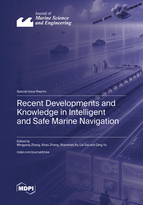Recent Developments and Knowledge in Intelligent and Safe Marine Navigation
A special issue of Journal of Marine Science and Engineering (ISSN 2077-1312). This special issue belongs to the section "Ocean Engineering".
Deadline for manuscript submissions: closed (20 August 2023) | Viewed by 17771
Special Issue Editors
Interests: maritime safety; big data analytics; machine learning; emerging maritime technologies
Special Issues, Collections and Topics in MDPI journals
Interests: autonomous ship; traffic management; intelligent maritime supervision; traffic simulation
Special Issues, Collections and Topics in MDPI journals
Interests: maritime safety; arctic shipping; cause analysis of maritime accidents; navigational risk assessment; risk and resilience of maritime transportation systems
Interests: green shipping; arctic shipping; shipping management; transport economics
Special Issue Information
Dear Colleagues,
Marine navigation is a critical backbone of international trade and the global economy, supporting more than 80% of global trade.
With the launch of intelligent shipping trails, emerging techniques have begun to play an important role in the maritime shipping domain. Intelligent and safe marine navigation can benefit from the development of artificial intelligence (AI), machine learning (ML), and big data analytic approaches in various aspects: intelligent shipping, traffic monitoring, early warning for critical scenarios, etc. Such cutting-edge techniques will enormously improve the intelligence and safety of ships now and in the future.
In light of these developments, the Journal of Marine Science and Engineering (JMSE) (https://www.mdpi.com/journal/jmse) is currently running a Special Issue (SI) entitled" Frontiers in Intelligent and Safe Marine Navigation".
This Special Issue seeks original contributions covering emerging and frontier technologies, especially the practical applications of the intelligence and safety of ongoing ships in real operational conditions. Topics of interest include, but are not limited to, the following:
- Multi-source data integration methods for supporting intelligence and safety of ships;
- Big data analytics methods for supporting the intelligence and safety of ships;
- Maritime traffic modeling and simulation methods;
- Maritime network extraction and route planning;
- Intelligent traffic monitoring methods/tools;
- Ship system identification methods;
- Ship motion/trajectory prediction methods;
- Early warning methods for operating ships (i.e., unsafe ship behaviors, illegal ship behaviors);
- Proactive risk mitigation methods (i.e., collision and grounding);
- Ship accident prevention methods/frameworks;
- Seafarers’ unsafe acts identification and alert methods;
- Decision-making techniques for critical scenario (i.e., collision and grounding) identification and prevention.
Dr. Mingyang Zhang
Prof. Dr. Xinyu Zhang
Dr. Shanshan Fu
Dr. Lei Dai
Dr. Qing Yu
Guest Editors
Manuscript Submission Information
Manuscripts should be submitted online at www.mdpi.com by registering and logging in to this website. Once you are registered, click here to go to the submission form. Manuscripts can be submitted until the deadline. All submissions that pass pre-check are peer-reviewed. Accepted papers will be published continuously in the journal (as soon as accepted) and will be listed together on the special issue website. Research articles, review articles as well as short communications are invited. For planned papers, a title and short abstract (about 100 words) can be sent to the Editorial Office for announcement on this website.
Submitted manuscripts should not have been published previously, nor be under consideration for publication elsewhere (except conference proceedings papers). All manuscripts are thoroughly refereed through a single-blind peer-review process. A guide for authors and other relevant information for submission of manuscripts is available on the Instructions for Authors page. Journal of Marine Science and Engineering is an international peer-reviewed open access monthly journal published by MDPI.
Please visit the Instructions for Authors page before submitting a manuscript. The Article Processing Charge (APC) for publication in this open access journal is 2600 CHF (Swiss Francs). Submitted papers should be well formatted and use good English. Authors may use MDPI's English editing service prior to publication or during author revisions.







